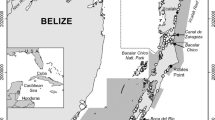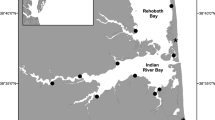Abstract
We analyzed historic and current fishery independent data to determine if the abundance of two apex predators, bull sharks (Carcharhinus leucas) and alligator gar (Atractosteus spatula), in Lake Pontchartrain had changed significantly over the last half century. Lake Pontchartrain is an environmentally degraded oligohaline estuary in southeastern Louisiana that has experienced considerable changes in fish assemblage composition over this interval. Using gillnet, beach seine, and trawl data collected during three time periods (1953–1955, 1977–1978, and 1996–2005), we analyzed trends in abundance forC. leucas andA. spatula using generalized linear models with a negative binomial error structure and a log link. Lake Pontchartrain data were divided into four spatial locations (northwest, northeast, southwest, southeast) since each region represents a unique combination of anthropogenic and natural influences that could affect catches. For each species and gear type, we produced log-likelihood profiles for the instantaneous rate of change in relative abundance through time. Raw catches were generally lower for both species in the later surveys.C. leucas were not captured in beach seines since the 1950s andA. spatula were rarely captured in trawls or seines since the 1970s. Likelihood profiles of changes in abundance forC. leucas andA. spatula showed very large declines in both species since 1953.C. leucas declined by 98.6% (95% CI: 73.4–99.9%) in gillnets and became functionally extirpated in beach seines with a decline of 99.9% (95% CI: 23–99.9%). Among all gears,C. leucas declined by the same rate as in gillnets. The decline inA. spatula was also large with a decrease of 98.6% (95% CI: 73.4–99.9%) in beach seines and a decline of 99.2% (95% CI: 54.8–99.9%) in trawls since 1953. Catches ofA. spatula in gillnets did not show a significant change over the study period. The continued decline of these two apex predators could seriously affect efforts to restore this degraded estuarine ecosystem.
Similar content being viewed by others
Literature cited
Aguilera, C., R. Mendoza, G. Rodríguez, andG. Márquez. 2002. Morphological description of alligator gar and tropical gar larvae, with an emphasis on growth indicators.Transactions of the American Fisheries Society 131:899–909.
Armitage, A. R. andP. Fong. 2004. Upward cascading effects of nutrients: Shifts in a benthic microalgal community and a negative herbivore response.Oecologia 139:560–567.
Barrowman, N. J. andR. A. Myers. 2003. Raindrop plots: A new way to display collections of likelihoods and distributions.The American Statistician 57:268–274.
Baum, J. K. andR. A. Myers. 2004. Shifting baselines and the decline of pelagic sharks in the Gulf of Mexico.Ecological Letters 7:135–145.
Baum, J. K., R. A. Myers, D. G. Kehler, B. Work, S. J. Harley, andP. A. Doherty. 2003. Collapse and conservation of shark populations in the Northwest Atlantic.Science 299:89–392.
Boschung, H. T., Jr. andR. L. Mayden. 2004. Fishes of Alabama, 1st edition. Smithsonian Books, Washington, D.C.
Chen, C. Y., R. S. Stemberger, B. Klaue, J. D. Blum, P. C. Pickhardt, andC. L. Folt. 2000. Accumulation of heavy metals in food web components across a gradient of lakes.Limnology and Oceanography 45:1525–1536.
Chesney, E. J., D. M. Baltz, andR. G. Thomas. 2000. Louisiana estuarine and coastal fisheries and habitats: Perspectives from a fish’s eye view.Ecological Applications 10:350–366.
Cho, J. and M. A. Poirrier. 2002. Biological resources — submersed aquatic vegetation, p. 126–127.In S. Penland, A. Beall, and J. Kindinger (eds.), Environmental Atlas of the Lake Pontchartrain Basin. Lake Pontchartrain Basin Foundation, U.S. Geological Survey Open File Report 2. CD-ROM (available at http://coastal.er.usgs.gov/pontchartrain/atlas). New Orleans, Louisiana.
Clark, E. andK. von Schmidt. 1965. Sharks of the Central Gulf coast of Florida.Bulletin of Marine Science 15:13–83.
Compagno, L. J. V. 1984. FAO species catalogue. Volume 4. Sharks of the world. An annotated and illustrated catalogue of shark species known to date. Part 2 — Carcharhiniformes.FAO Fisheries Synopsis 125:251–655.
Cook, F. A. 1959. Freshwater Fishes of Mississippi, 1st edition. Mississippi Game and Fish Commission, Jackson, Mississippi.
Darnell, R. M. 1962. Ecological history of Lake Pontchartrain, an estuarine community.American Midland Naturalist 68:434–444.
Douglas, N. H. 1974. Freshwater Fishes of Louisiana. Claitor’s Publishing, Baton Rouge, Louisiana.
Etnier, D. A. andW. C. Starnes. 1993. The Fishes of Tennessee. University of Tennessee Press, Knoxville, Tennessee.
Francis, J. C. andM. A. Poirrier. 1999. Recent trends in Secchi depth of Lake Pontchartrain.Gulf Coast Research Reports 11:1–5.
Fraser, D. F., J. F. Gilliam, B. W. Albanese, andS. B. Snider. 2006. Effects of temporal patterning of predation threat on movement of a stream fish: Evaluating an intermediate threat hypothesis.Environmental Biology of Fish 76:25–35.
GarciaDeLeon, F. J., L. Gonzalez-Garcia, J. M. Herrera-Castillo, K. O. Winemiller, andA. Banda-Valdes. 2001. Ecology of the alligator gar,Atractosteus spatula, in the Vicente Guerrero Reservoir, Tamaulipas, Mexico.Southwestern Naturalist 46:151–157.
Gilbert, C. R. 1992. Alligator gar —Atractosteus spatula.In C. R. Carter (ed.), Rare and Endangered Biota of Florida, Volume II. Fishes. University Press of Florida, Gainesville, Florida.
Gilliam, J. F. andD. F. Fraser. 1987. Habitat selection under predation hazard: Test of a model with stream-dwelling minnows.Ecology 68:1856–1862.
Goodyear, C. 1967. Feeding habits of three species of gars,Lepisosteus, along the Mississippi Gulf Coast.Transactions of the American Fisheries Society 96:296–300.
Hughes, A. R., K. J. Bando, L. F. Rodriguez, andS. L. Williams. 2004. Relative effects of grazers and nutrients on seagrasses: A meta-analysis approach.Marine Ecology Progress Series 282:87–99.
Jackson, J. B. C., M. X. Kirby, W. H. Berger, K. A. Bjorndal, L.W.Botsford, B. J. Bourque, R. H. Bradbury, R. Cooke, J. Erlandson, J. A. Estes, T. P. Hughes, S. Kidwell, C. B. Lange, H. S. Lenihan, J. M. Pandolfi, C. H. Peterson, R. S. Steneck, M. J. Tegner, andR. R. Warner. 2001. Historical overfishing and the recent collapse of coastal ecosystems.Science 293:629–638.
Lambou, V. W. 1952. Food and habitat of gar fish in the tide water of southeastern Louisiana. M.S. Thesis, Louisiana State University at Baton Rouge, Baton Rouge, Louisiana.
Lotze, H. K., H. S. Lenihan, B. J. Bourque, R. H. Bradbury, R. G. Cooke, M. C. Kay, S. M. Kidwell, M. X. Kirby, C. H. Peterson, andJ. B. C. Jackson. 2006. Depletion, degradation, and recovery potential of estuaries and coastal seas.Science 312: 1806–1809.
Mason, R. P. andK. A. Sullivan. 1997. Mercury in Lake Michigan.Environmental Science and Technology 31:942–947.
McCullagh, P. andJ. A. Nelder. 1989. Generalized Linear Models. Chapman and Hall, London, England.
Myers, R. A., J. K. Baum, T. J. Shepherd, S. P. Powers, andC. H. Peterson. 2007. Cascading effects of the loss of apex predatory sharks from a coastal ocean.Science 315:1846–1850.
O’Connell, M. T., R. C. Cashner, andC. S. Schieble. 2004. Fish assemblage stability over fifty years in the Lake Pontchartrain Estuary; comparisons among habitats using canonical correspondence analysis.Estuaries 27:807–817.
O’Connell, M. T., R. C. Cashner, andC. S. Schieble. 2006. Fish assemblage instability and hydrologic influences in Lake Pontchartrain, Louisiana (USA), a degraded oligohaline estuary, p. 361–370.In Y. Jun Xu and V. P. Singh (eds.), Coastal Environment and Water Quality. Water Resources Publication (LLC), Highlands Ranch, Colorado.
O’Connell, M. T., C. D. Franze, E. A. Spalding, andM. A. Poirrier. 2005. Biological resources of the Louisiana coast: Part 2. Coastal animals and habitat associations.Journal of Coastal Research 44:146–161.
Penland, S., P. McCarty, A. Beall, and D. Maygarden. 2002. Environmental overview of the Lake Pontchartrain Basin, p. 3–6.In S. Penland, A. Beall, and J. Kindinger (eds.), Environmental Atlas of the Lake Pontchartrain Basin. Lake Pontchartrain Basin Foundation, U.S. Geological Survey Open File Report 2. CD-ROM (available at http://coastal.er.usgs.gov/pontchartrain/ atlas). New Orleans, Louisiana.
Peterson, M. S., B. H. Comyns, J. R. Hendon, P. A. Bond, andG. A. Duff. 2000. Habitat use by early life-history stages of fishes and crustaceans along a changing estuarine landscape: Differences between natural and altered shoreline sites.Wetlands Ecology and Management 8:209–219.
Pflieger, W. L. 1997. The Fishes of Missouri, revised edition. Missouri Department of Conservation, Jefferson City, Missouri.
Posey, M. H., T. D. Alphin, andL. Cahoon. 2006. Benthic community responses to nutrient enrichment and predator exclusion: Influence of background nutrient concentrations and interactive effects.Journal of Experimental Marine Biology and Ecology 330:105–118.
Power, M. E. 1990. Effects of fish in river food webs.Science 250: 811–814.
Pringle, C. M., M. Freeman., andB. Freeman. 2000. Regional effects of hydrologic alterations on riverine macrobiota in the New World: Tropical-temperate comparisons.BioScience 50: 807–823.
Ross, S. T., W. M. Brenneman, W. T. Slack, M. T. O’Connell, andT. L. Peterson. 2001. The Inland Fishes of Mississippi, 1st edition. University Press of Mississippi, Jackson, Mississippi.
Scarnecchia, D. L. 1992. A reappraisal of gars and bowfins in fishery management.Fisheries 17:6–12.
Shepherd, T. D. andR. A. Myers. 2005. Direct and indirect fishery effects on small coastal elasmobranchs in the northern Gulf of Mexico.Ecology Letters 8:1095–1104.
Stone, J. H. 1980. Environmental analysis of Lake Pontchartrain, Louisiana, its surrounding wetlands and selected land uses. Prepared for the U.S. Army Corps of Engineers District, New Orleans, Louisiana.
Suttkus, R. D., R. M. Darnell, and J. H. Darnell. 1954. Biological study of Lake Pontchartrain. Tulane University Zoology Department. Annual Report submitted to the Louisiana Department of Wildlife and Fisheries. New Orleans, Louisiana.
Terborgh, J., L. Lopez, P. Nunez, V. M. Rao, G. Shahabuddin, G. Orihuela, M. Riveros, R. Ascanio, G. H. Adler, T. D. Lambert, andL. Balbas. 2001. Ecological meltdown in predator-free forest fragments.Science 294:1923–1926.
Thompson, B. A. and G. R. Fitzhugh. 1985. Synthesis and analysis of Lake Pontchartrain environments, influencing factors and trends. Report submitted to the Office of Water Resources, Louisiana Department of Environmental Quality, Baton Rouge, Louisiana.
Ward, P. andR. A. Myers. 2005. Shifts in open-ocean fish communities coinciding with the commencement of commercial fishing.Ecology 86:835–847.
Weaver, J. E. 1969. Otter trawl and benthic studies in an estuary at Marsh Island, Louisiana. M.S. Thesis, Louisiana State University at Baton Rouge, Baton Rouge, Louisiana.
Source of Unpublished Materials
Simpfendorfer, C. and G. H. Burgess. 2000.Carcharhinus leucas. In 2006 IUCN Red List of Threatened Species. www.iucnredlist. org. Downloaded on 13 October 2006.
Author information
Authors and Affiliations
Corresponding author
Rights and permissions
About this article
Cite this article
O’Connell, M.T., Shepherd, T.D., O’Connell, A.M.U. et al. Long-term declines in two apex predators, bull sharks (Carcharhinus leucas) and alligator gar (Atractosteus spatula), in Lake Pontchartrain, an oligohaline estuary in southeastern Louisiana. Estuaries and Coasts: J ERF 30, 567–574 (2007). https://doi.org/10.1007/BF02841954
Received:
Revised:
Accepted:
Issue Date:
DOI: https://doi.org/10.1007/BF02841954




